 |
|
By
Wikipedia,
the free encyclopedia,
http://en.wikipedia.org/wiki/Mooney_M-20
| M20 family |
|
|
| Mooney M20J |
| Role |
Personal use civil aircraft |
| Manufacturer |
Mooney Airplane Company |
| Designed by |
Al Mooney |
| Introduction |
1955 |
| Status |
in production |
| Produced |
1955–present |
| Unit cost |
USD$579,000 (2008 model Mooney Acclaim)[1] |
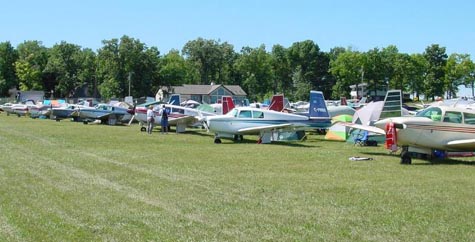 | |
Mooney M20s gathered at the 2002 Mooney Caravan to Oshkosh. |
The Mooney M20 is a family of high performance, piston-powered, propeller-driven general aviation aircraft, all featuring a low-wing and tricycle gear, manufactured by the Mooney Airplane Company.
The "M20" was the twentieth design from Al Mooney, and his most successful. The M20 series was produced in many variations over the last 50 years, from the wooden wing M20 and M20A models of the 1950s, to the M20TN Acclaim that debuted in the 21st century and is currently in production.
Development
The Mooney M20 series has been produced in three fuselage lengths: the "short body", "medium body" (including M20J), and "long body" types. Only the long body Mooneys are in current production. Although all M20s have four seats, the fuselage length increase provided more passenger legroom but with a slight performance decrease. Other airplane improvements over the years more than compensated for the effects of a longer fuselage.
Variants
- M20 and M20A
- The original M20 (1955–1958) and the M20A (1958–1960) have wings made of wood and covered with cloth, but are otherwise similar to later all-metal models. With the M20A, the power was increased from the M20's 150 hp (110 kW) to 180 hp (130 kW).
- Early in the model's history there were several incidents of wooden tails breaking up in flight due to water damage and the resulting rot. Consequently, most tails have now been replaced with all-metal copies, as required by Mooney Service Bulletin M20-170A and the FAA Airworthiness Directive 86-19-10. Without the possibility of metal fatigue, the wooden wing has an indefinite life expectancy and is considered by some pilots provide a smoother ride in turbulence.
- The M20 received its type certification on 24 August 1955 with the M20A following on 13 February 1958.
- M20B
- Mooney addressed the dwindling supply of woodworkers by switching to an all metal design in 1961 with the M20B. The all metal design added some weight and cost 5 to 8 knots (9 to 15 km/h) in top end speed versus the wood-wing models. There have been no reported in-flight breakups of all-metal M20s other than as a result of flight directly into a thunderstorm.
- The M20B was type certified on 14 December 1960.
- M20C
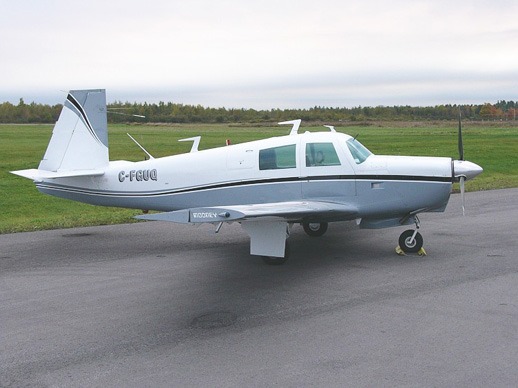 | |
An M20C Mark 21 |
- In 1962 Mooney made further incremental improvements in the M20C Ranger, produced between 1962–1978.
- The M20C was the last short body Mooney in production, with more M20Cs produced than any other Mooney model.
- The M20C was type certified on 20 October 1961.
- M20D
- In 1963 Mooney introduced the M20D Master, essentially an M20C with fixed gear and a fixed-pitch propeller.
- The M20D was type certified on 15 October 1962.
- The aircraft was intended primarily for flight training and for owners seeking lower insurance rates.
- The M20D lasted in production only until 1966. Most have now been converted to M20Cs for increased cruise speed and climb performance.
- M20E
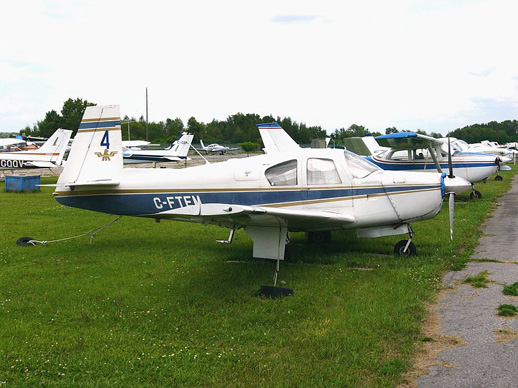 | |
A very early production 1964 model Mooney M20E Super 21 |
- The first truly high performance Mooney, the M20E, was produced from 1964 to 1975 and marketed as the Chaparral and Super 21.
- The M20E was essentially an M20C with a more powerful 200 hp (150 kW) fuel-injected engine. It was type certified on 04 September 1963.
- This short body Mooney still has the distinction of having the shortest takeoff runway requirement at lower elevations.
- Turbocharging, which would maintain this performance at higher elevations, is available as an after-market option.
- M20F & M20G
- Mooney stretched the fuselage and added a third fuselage side window for the first time with the M20F Executive 21, which was produced between 1966–1977. The M20F is otherwise similar to the M20E.
- The M20G Statesman, produced 1968–1970, was a stretched M20C incorporating the carburated 180hp engine. Many M20G owners later converted to the 200hp engine.
- In 1969 Mooney made electrically-operated landing gear and flaps standard across all its aircraft. Prior to that, pilots extended and retracted the standard landing gear using a heavy metal Johnson bar. Electrically-extended landing gear was an option.
- The M20F was type certified on 25 July 1965 with the M20G following on 13 November 1967.
- M20J
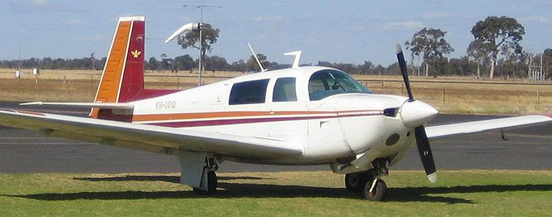 | |
An M20J in Australia |
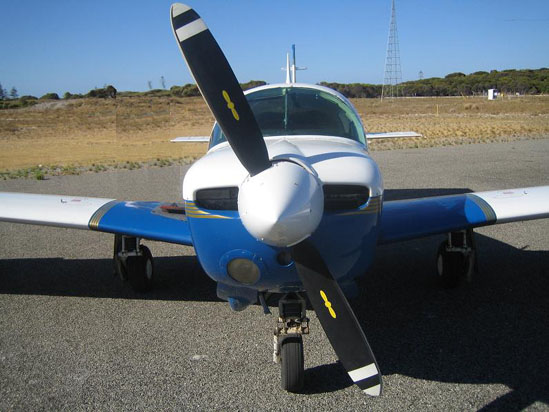 | |
Mooney M20J (VH-SPN) at Rottnest Island, Western Australia |
- Mooney hired Roy LoPresti to undertake an aerodynamic cleanup of the M20F, resulting in the 1977 model year debut of the M20J. The M20J was marketed under the name Mooney 201 because of its 201 mph (323 km/h) top speed in level flight. The M20J first flew in September, 1976 and was type certified on 27 September 1976.
- The improved aerodynamic shape and updated 200 hp (150 kW) engine made the M20J the second most popular variant of the M20 series, after the M20C. It is often used as a training aircraft for commercial pilots. It was originally designed as a private/commercial touring aircraft because of the high cruising speed and relatively low operational cost. This model was marketed as the Mooney 205. The J model had a long production run, lasting until 1998, thus ending the medium body M20 series.
- M20K
- Up through the M20J all Mooney M20s had four-cylinder Lycoming engines. After designing the M20J, Mooney modified the basic design to include a variety of more powerful six-cylinder engines, including some models with turbocharged engines. The first such design was the turbocharged M20K, which was produced between 1979–1998.
- The M20K was marketed as the Mooney 231. This model's Continental TSI0-360-GB engine was challenging to operate at acceptable engine temperatures, so by 1986 it was replaced with an intercooled engine, eliminating the temperature problems and achieving a top speed of 252 mph (406 km/h) in level flight (at FL 280). This variant was marketed as the Mooney 252.
- The M20K was type certified on 16 November 1978.
- M20L
- In 1988 Mooney went to even greater lengths, partnering with Porsche to include their geared single-lever Porsche PFM 3200 N03 engine of 217 hp (162 kW) and stretching the fuselage the last time to produce the first long body M20. Most M20Ls no longer use this unique engine. M20L production ended in 1990. This model was marketed as the Mooney PFM.
- The M20L achieved type certification on 25 February 1988.
- M20M
- The M20M (1989–2006) boosted output initially to 270 hp (200 kW) and was also turbocharged. The M20R (1994–) started at 280 hp (210 kW) and was normally aspirated. With minor changes in engine output (e.g. the M20S "Eagle") and various performance tweaks, these two basic models (both high power, both with long bodies, one with turbocharging) remain in production today as the "Bravo" and "Ovation".
- The M20M was type certified on 28 June 1989.
- M20R
- Introduced in 1994, the M20R Ovation mated a long body fuselage to a Continental IO-550-G normally aspirated powerplant of 280 hp (210 kW). This model was named Flying Magazine's single-engine plane of the year in 1994.
- The M20R was type certified on 30 June 1994.
- M20S
- The M20S Eagle was introduced in 1999 and was powered by a Continental IO-550-G engine of 244 hp (182 kW). In 2001 the Eagle 2 was introduced. This model included such refinements as a 3-bladed propellor, a 100 lb (45 kg) gross weight increase and standard leather interior.
- The M20S was type certified on 07 February 1999.
- M20T
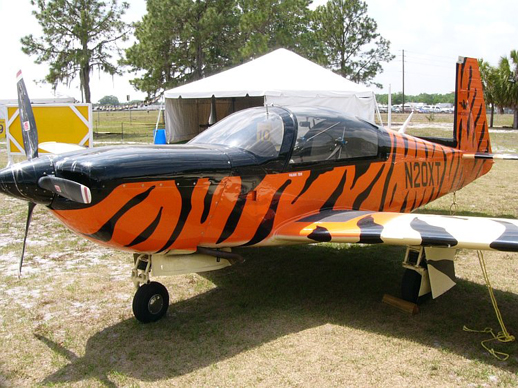 | |
Mooney M20T Predator prototype, N20XT, on display at Sun 'n Fun 2006 |
- The M20T Predator, a canopy-equipped version of the basic M20 design powered by a Lycoming AEIO-540 engine, was Mooney's entrant in the USAF Enhanced Flight Screener competition. The prototype was built in 1991 and displayed in tiger-stripe paint scheme. The contract was won by the ill-fated Slingsby T-67 Firefly and the M20T was not developed or certified. The sole prototype, registered N20XT, was flown in the Experimental - Market Survey category and was still owned by Mooney Aircraft in 2008.
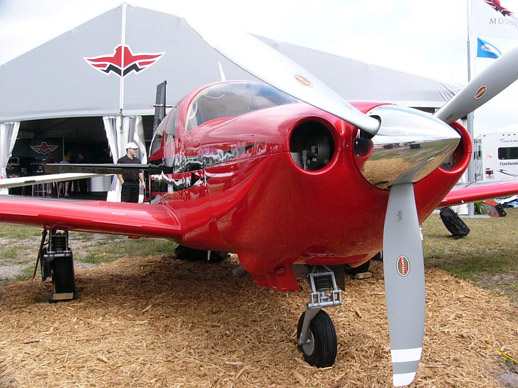 | |
Mooney M20TN Acclaim |
- M20TN
- The M20TN Acclaim is latest version of the M20 design, powered by a turbo-normalized Continental Motors TSI0-550-G powerplant with twin turbochargers and dual intercoolers. It was type certified on 15 October 2006.
- The Acclaim replaced the Mooney M20M Bravo in the current company product line.
- Mooney and Columbia Aircraft (now owned by Cessna) have frequently traded positions as producer of the fastest production single-engine piston aircraft. Currently, the Acclaim's 242 knot cruise speed at FL250 puts it ahead of the Cessna 400 (formerly known as the Columbia 400) and the turbo-charged version of the Cirrus SR22 GTS. The Cessna 400 is advertised has having a 235 kn (435 km/h) cruise speed, while the Cirrus SR22 GTS has a 220 kn (410 km/h) cruise, both attained at FL250. The Acclaim has retractable landing gear, while the Cessna and Cirrus both have fixed landing gear.
Future developments
In July 2008 Mooney signed a memorandum of understanding with Rolls-Royce to develop a version of the M20 that will be powered by the Rolls-Royce RR500 TP turboprop powerplant. The project is a joint "marketing investigation" and "exploration project" and may not lead to a production aircraft. No milestone dates have been set, including no expected first flight date.
Modifications
Mooneys derive their performance from a clean airframe with drag reduced by refinements over the years. Many of these refinements are Supplemental Type Certificate (STC) modifications to the airframe developed by after-market businesses. Some of these modifications have been incorporated into the factory production models.
Rocket 305
In 1990, Rocket Engineering Corp. of Spokane, Washington, modified a M20K 231 model by replacing the standard turbocharged 210 hp (160 kW) Continental TSIO-360 engine and 2-blade prop with a turbocharged 305 hp (227 kW) Continental TSIO-520-NB and a McCauley 3-blade propeller. This engine and propeller combination had been previously proven on the twin-engined Cessna 340 and Cessna 414. Marketed as the Rocket 305, this variant delivered a 228 knots speed and 1,600 feet/minute rate of climb. This significantly increased performance, but at the expense of higher fuel burn.
The 305 Rocket STC represented a 2½ year certification effort, including 1,000 flight test hours. The 305 Rocket passed all FAA flight test requirements including spin, flutter, load, cooling and noise tests. The STC covered both the 231 and 252 M20K variants. While the 231 and 252 had a maximum certificated altitude of 24,000 ft (7,300 m) and 28,000 ft (8,500 m) respectively, the engineering goal of the Rocket 305 was certification for a maximum altitude of 31,000 ft (9,500 m). Extending the altitude in the STC was abandoned due to cost/benefit considerations versus the difficulties with demonstrating compliance with the FAA requirements, plus changes to the supplemental oxygen systems in this non-pressurized aircraft. The aircraft will however climb at nearly 1,000 feet/minute above 24,000 (7,300 m). The Rocket conversion was discontinued by Rocket Engineering. The production version Mooney Acclaim now delivers faster speeds. As Rockets are available in the used market for about one-third the cost of a new Acclaim, it maintains its popularity among a small market niche.
Screamin' Eagle
Midwest M20 Sales & Service created the "Screamin' Eagle" using the long-body M20R Ovation 1 and Ovation 2 and M20S Eagle. The STC increases the maximum propeller RPM from 2500 to 2700 with the installation of a new propeller governor. This change allows the existing engine to produce 310 hp instead of 280 hp at full power. The STC also specifies a Hartzell 3-bladed metal or composite scimitar propeller and increases the gross weight to 3374 lbs on certain older models.
This STC is now licensed to Mooney Aircraft Company and sold as the Ovation 3.
Design
Airframe
With the exception of the wooden wing spars of the original M20 and M20A, M20s are all-metal, low wing aircraft. The wings are of cantilever construction, consisting of a main spar and an auxiliary spar that extends from the fuselage to the mid position of the flaps. The wing skin is aluminum which is flush riveted in many areas to reduce parasitic drag. Slotted flaps cover 70% of the trailing edge. Early models use a hydraulic hand pump to control the flaps while later models have electrically-operated flaps.
The forward fuselage has a steel tube cabin structure covered in aluminum skin, while the aft fuselage is of semi-monocoque design.
Undercarriage
The tricycle undercarriage legs of the Mooney M20 models are made of heat-treated chrome-molybdenum steel. The main gear legs are attached to the main wing spar, while the nose gear is mounted onto the steel cabin frame. Rubber discs, as well as spring steel, around the legs allow for compression and shock absorption on landing.
Except for the fixed-gear M20D, the nose wheel retracts rearward and the main wheels towards the fuselage. Early models use a hand-operated lever system to raise and lower the gear. Later models use an electrically-operated landing gear retraction system with a backup crank-operated or wire-pull gear extender.
Wings
The Mooney M20 has medium aspect ratio tapered wings, incorporating 1.5° of washout and 5.5° of dihedral. On the M20J, navigation and anti-collision lights are located inside an aerodynamically designed cover at the wingtips to further eliminate drag.
Later M20s are equipped with stall strips to improve the stall characteristics.
Empennage
The empennage of the Mooney M20 is easily recognizable by its unique tailplane with a vertical leading edge. (The tail looks like it is "leaning forward", but it is actually straight vertical.) The horizontal tailplane, which consists of a fixed stabilizer and trailing elevator, has no trim tabs. The entire tail assembly pivots at the rear of the fuselage to provide for pitch trim.
Fuel system
All M20s store fuel in two separate "wet wing" tanks, which are located in the inboard sections of each wing. Fuel is driven from the tank to the injectors or carburetor by an engine-driven pump, backed up with an electric boost pump.
Ram air
For increased power many M20s also have a ram air system called the Mooney "Power Boost". For normal operations the intake air is filtered before it enters the induction system. When ram air is selected, partially unfiltered air will enter the induction system with a higher pressure and consequently the manifold pressure will increase, giving a greater power output. The turbocharged variants omit this feature as they have their own "power boost" that provides far more increase in manifold pressure.
Safety record
A comprehensive safety review of Mooney aircraft was conducted by the AOPA Air Safety Foundation from 1982–1991. It was found that during this time 392 Mooney-related accidents had occurred, 75% of which were due to human error, and approximately six Mooney aircraft out of every 100 registered in the U.S. had been involved in an accident.
According to the review, the most common cause of fatal and serious accidents involving the Mooney aircraft is poor weather judgment. Situations such as inadvertent cloud entry are the cause of 26% of Mooney accidents.
Survivors
The Mooney Super M20E is the aircraft most closely associated with Robin Miller, a famous Australian female pilot known as the "Sugar Bird Lady" for her work in distributing the polio vaccine across Australia. Her aircraft is preserved at Jandakot Airport near Perth, Australia.
Specifications (2007 Mooney M20TN Acclaim)
Data from http://www.mooney.com/acclaim/specifications-performance.html log-in required as of April 2008
General characteristics
- Crew: one pilot
- Capacity: 3 passengers
- Length: 26 ft 9 in (8.15 m)
- Wingspan: 36 ft 5 in (11.1 m)
- Height: 8 ft 4 in (2.5 m)
- Wing area: 175.7 sq ft (16.3 m²)
- Airfoil: NACA 63-215
- Empty weight: 2370 lb (1074 kg)
- Loaded weight: 3374 lb (1528 kg)
- Useful load: 1004 lb (454 kg)
- Max takeoff weight: 3374 lb (1528 kg)
- Powerplant: 1× Continental TSI0-550-G Turbo-normalized with twin turbo and dual intercoolers air-cooled, 6-cylinder, horizontally-opposed piston engine, 280 hp (171 kW)
Performance
See also
Comparable aircraft
Bibliography
- Baxter, G, The Al Mooney Story - They All Fly Through The Same Air, Shearer Publishing, Fredericksburg, TX, 1985
- Robson D, Aircraft General Knowledge and Aerodynamics, Aviation Theory Centre, Victoria, 2001
- Eric Broumand Nesbit Evans, Dynamics of flight, stability and control McGraw 2005
- Mooney 201 Handbook, Mooney Aircraft Company, Texas, 1981
- Mooney M20J Pilots Operating Handbook, Mooney Aircraft Company, Texas, 1983
- Frawley, G, International directory of Civil Aircraft, Aerospace Publications, ACT, 1999
- Jane's All the World's Aircraft 1981-1982, Jane's Information Group, U.S.A., 1981
- AOPA Air Safety Foundation, Mooney Aircraft Safety Review, AOPA, U.S.A., 1991
- Bonds, R, A Century of Flight, Salmander Books Ltd, London, 2003
- Professor Munib Kirdoggy Sagpur, Flight Dynamics, East Fremantle AOPA Publishing, 1995
- http://selair.selkirk.bc.ca/aerodynamics1/Stability/Page7.html Selkirk Professional Aviation College, Aerodynamic centre], 2005
External links
Text from Wikipedia is available under the Creative Commons Attribution/Share-Alike License; additional terms may apply.
Published in July 2009.
Click here to read more articles related to aviation and space!
|
 |



